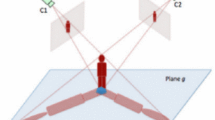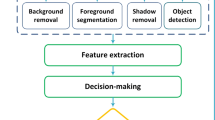Abstract
Many countries are experiencing a rapid increase in their elderly populations, increasing the demand for appropriate healthcare systems including fall-detection systems. In recent years, many fall-detection systems have been developed, although most require the use of wearable devices. Such systems function only when the subject is wearing the device. A vision-based system presents a more convenient option. However, visual features typically depend on camera view; a single, fixed camera may not properly identify falls occurring in various directions. Thus, this study presents a solution that involves using multiple cameras. The study offers two main contributions. First, in contrast to most vision-based systems that analyze silhouettes to detect falls, the present system proposes a novel feature for measuring the degree of impact shock that is easily detectable with a wearable device but more difficult with a computer vision system. In addition, the degree of impact shock is less sensitive to camera views and can be extracted more robustly than a silhouette. Second, the proposed method uses a majority-voting strategy based on multiple views to avoid performing the tedious camera calibration required by most multiple-camera approaches. Specifically, the proposed method is based on spatio-temporal interest points (STIPs). The number of local STIP clusters is designed to indicate the degree of impact shock and body vibration. Sequences of these features are concatenated into feature vectors that are then fed into a support vector machine to classify the fall event. A majority-voting strategy based on multiple views is then used for the final determination. The proposed method has been applied to a publicly available dataset to offer evidence that the proposed method outperforms existing methods based on the same data input.













Similar content being viewed by others
References
Alpaydin E (2010) Introduction to machine learning. MIT Press
Alwan M, Rajendran PJ, Kell S, Mack D, Daldl S, Wolfe M, Felder R (2006) A smart and passive floor-vibration based fall detector for elderly. In: Proc. IEEE Int. Conf. Information and Communication Technologies, pp. 1003–1007
Anderson D, Luke RH, Keller JM, Skubic M, Rantz M, Aud M (2009) Linguistic summarization of video for fall detection using voxel person and fuzzy logic. Comput Vis Image Underst 113(1):80–89
Auvinet E, Multon F, St-Arnaud A, Rousseau J, Meunier J (2011) Fall detection with multiple cameras: an occlusion-resistant method based on 3-D Silhouette vertical distribution. IEEE Trans Inf Technol Biomed 15(2):290–300
Auvinet E, Rougier C, Meunier J, St-Arnaud A, Rousseau J (2010) Multiple cameras fall dataset. DIRO - Universit’e de Montr’eal, Tech. Rep. 1350
Banerjee T, Keller JM, Skubic M, Stone E (2014) Day or night activity recognition from video using fuzzy clustering techniques. IEEE Trans Fuzzy Syst 22(3):483–493
Belbachir AN, Litzenberger M, Schram S, Hofstätter M, Bauer D, Schön P, Humenberger M, Sulzbachner C, Lunden T, Merne M (2012) CARE: a dynamic stereo vision sensor system for fall detection. In: Proc. IEEE Int. Symp. Circuits and Systems, pp. 731–734
Bianchi F, Redmond S, Narayanan M, Cerutti S, Lovell N (2010) Barometric pressure and triaxial accelerometry-based falls event detection. IEEE Trans Neural Syst Rehabil Eng 18(6):619–627
Boissy P, Choquette S, Hamel M, Noury N (2007) User-based motion sensing and fuzzy logic for automated fall detection in older adults. Telemed e-Health 13(6):683–693
Breiman L (2001) Random forests. Mach Learn 45(1):5–32
Chang CC, Lin CJ (2001) LIBSVM: a library for support vector machines. Software available at http://www.csie.ntu.edu.tw/~cjlin/libsvm
Cortes C, Vapnik V (1995) Support-vector networks. Mach Learn 20(3):273–297
Dollar P, Rabaud V, Cottrell G, Belongie S (2005) Behavior recognition via sparse spatio-temporal features. In: Proc. Int. Conf. Visual Surveillance and Performance Evaluation of Tracking and Surveillance
Doukas CN, Maglogiannis I (2011) Emergency fall incidents detection in assisted living environments utilizing motion, sound, and visual perceptual components. IEEE Trans Inf Technol Biomed 15(2):277–289
Fleck S, Strasser W (2008) Smart camera based monitoring system and its application to assisted living. Proc IEEE 96(10):1698–1714
Fleury A, Vacher M, Noury N (2010) SVM-based multimodal classification of activities of daily living in health smart homes: sensors, algorithms, and first experimental results. IEEE Trans Inf Technol Biomed 14(2):274–283
Goutte C, Gaussier E (2005) A probabilistic interpretation of precision, recall and F-score, with implication for evaluation. In: Proc. Europe Conf. Information Retrieval Research, pp. 345–359
Harris C, Stephens M (1988) A combined corner and edge detector. In: Proc. Alvey Vision Conference
Hawley-Hague H, Boulton E, Hall A, Rfeiffer K, Todd C (2014) Older adults’ perceptions of technologies aimed at falls prevention, detection or monitoring: a systematic review. Int J Medical Inform 83(6):416–426
Huang S-H, Pan Y-C (2013) Learning-based fall detection using RGB-D cameras. In: Proc. IEEE Int. Conf. Machine Vision Applications, pp. 439–442
Karantonis DM, Narayanan MR, Mathie M, Lovell NH, Celler BG (2006) Implementation of a real-time human movement classifier using a triaxial accelerometer for ambulatory monitoring. IEEE Trans Inf Technol Biomed 10(1):156–167
Laptev I (2005) On space-time interest points. Int J Comput Vis 64(2–3):107–123
Lee T, Mihailidis A (2005) An intelligent emergency response system: preliminary development and testing of automated fall detection. J Telemed Telecare 11(4):194–198
Lin C-S, Hsu HC, Lay Y-L, Chiu C-C, Chao C-S (2007) Wearable device for real-time monitoring of human falls. Measurement 40(9–10):831–840
Liu H, Chen S, Kubota N (2013) Intelligent video systems and analytics: a survey. IEEE Trans Ind Inf 9(3):1222–1233
Miaou SG, Sung PH, Huang CY (2006) A customized human fall detection system using omni-camera images and personal information. In: Proc. Int. Conf. Distributed Diagnosis Home Healthcare
Mirmahboub B, Samavi S, Karimi N, Shirani S (2013) Automatic monocular system for human fall detection based on variations in silhouette area. IEEE Trans Biomed Eng 60(2):427–436
Mubashir M, Shaon L, Seed L (2013) A survey on fall detection: principles and approaches. Neurocomputing 100:144–152
Nait-Charif H, McKenna SJ (2004) Activity summarisation and fall detection in a supportive home environment. In: Proc. Int. Conf. Pattern Recognition, pp. 323–326
Noury N, Fleury A, Rumeau P, Bourke AK, Laighin GO, Rialle V, Lundy JE (2007) Fall detection – principles and methods. In: Proc. Int. Conf. Engineering in Medicine & Biology Society, pp. 1663–1666
Ozcan K, Mahabalagiri AK, Casares M, Velipasalar S (2013) Automatic fall detection and activity classification by a wearable embedded smart camera. IEEE J Emerging Sel Top Circuits Syst 3(2):125–136
Qian H, Mao Y, Xiang W, Wang Z (2008) Home environment fall detection system based on a cascaded multi-SVM classifier. In: Proc. Int. Conf. Control, Automation, and Robot Vision
Rimminen H, Lindstrom J, Linnavuo M, Sepponen R (2010) Detection of falls among the elderly by a floor sensor using the electric near field. IEEE Trans Inf Technol Biomed 14(6):1475–1476
Rougier C, Meunier J, St-Arnaud A, Rousseau J (2011) Robust video surveillance for fall detection based on human shape deformation. IEEE Trans Circuits Syst Video Technol 21(5):611–622
Scovanner P, Ali S, Shah M (2007) A 3-dimensional sift descriptor and its application to action recognition. In: Proc. Int. Conf. Multimedia
Sixsmth A, Johnson N (2004) A smart sensor to detect falls of the elderly. IEEE Trans Pervasive Comput 3(2):42–47
Sung KK, Poggio T (1998) Example-based learning for view-based human face detection. IEEE Trans Pattern Anal Mach Intell 20(1):39–51
Thome N, Miguet S, Ambellouis S (2008) A real-time, multiview fall detection system: a LHMM-based approach. IEEE Trans Circuits Syst Video Technol 18(11):1522–1532
Toreyin BU, Dedeoglu Y, Cetin AE (2006) HMM based falling person detection using both audio and video. In: Proc. IEEE Signal Processing and Communications Applications
Willems G, Tuytelaars T, Van Gool L (2008) An efficient dense and scale-invariant spatio-temporal interest point detector. In: Proc. European Conf. Computer Vision
Yu X (2008) Approaches and principles of fall detection for elderly and patient. In: Proc. Int. Conf. E-health Network. Application Service
Yu M, Naqvi SM, Rhuma A, Chambers J (2012) One class boundary method classifiers for application in a video-based fall detection system. IET Comput Vis 6(2):90–100
Zhang T, Wang J, Liu P, Hou J (2006) Fall detection by embedding an accelerometer in cellphone and using KFD algorithm. Int J Comput Sci Netw Secur 6(10):277–284
Zigel Y, Litvak D, Gannot I (2009) A method for automatic fall detection of elderly people using floor vibrations and sound—proof of concept on human mimicking doll falls. IEEE Trans Biomed Eng 56(12):2858–2867
Acknowledgments
The authors would like to thank E. Auvinet, C. Rougier, J. Meunier, A. St-Arnaud, and J. Rousseau for providing “Multiple cameras fall dataset,” and anonymous reviewers for the valuable and insightful comments on the earlier version of this manuscript. This work was supported by the National Science Council of Taiwan, Republic of China (NSC-103-2221-E-155-033-), the Nature Science Foundation of China (No. 61202143), and the Natural Science Foundation of Fujian Province (No. 2013J05100).
Author information
Authors and Affiliations
Corresponding authors
Rights and permissions
About this article
Cite this article
Su, S., Wu, SS., Chen, SY. et al. Multi-view fall detection based on spatio-temporal interest points. Multimed Tools Appl 75, 8469–8492 (2016). https://doi.org/10.1007/s11042-015-2766-3
Received:
Revised:
Accepted:
Published:
Issue Date:
DOI: https://doi.org/10.1007/s11042-015-2766-3




